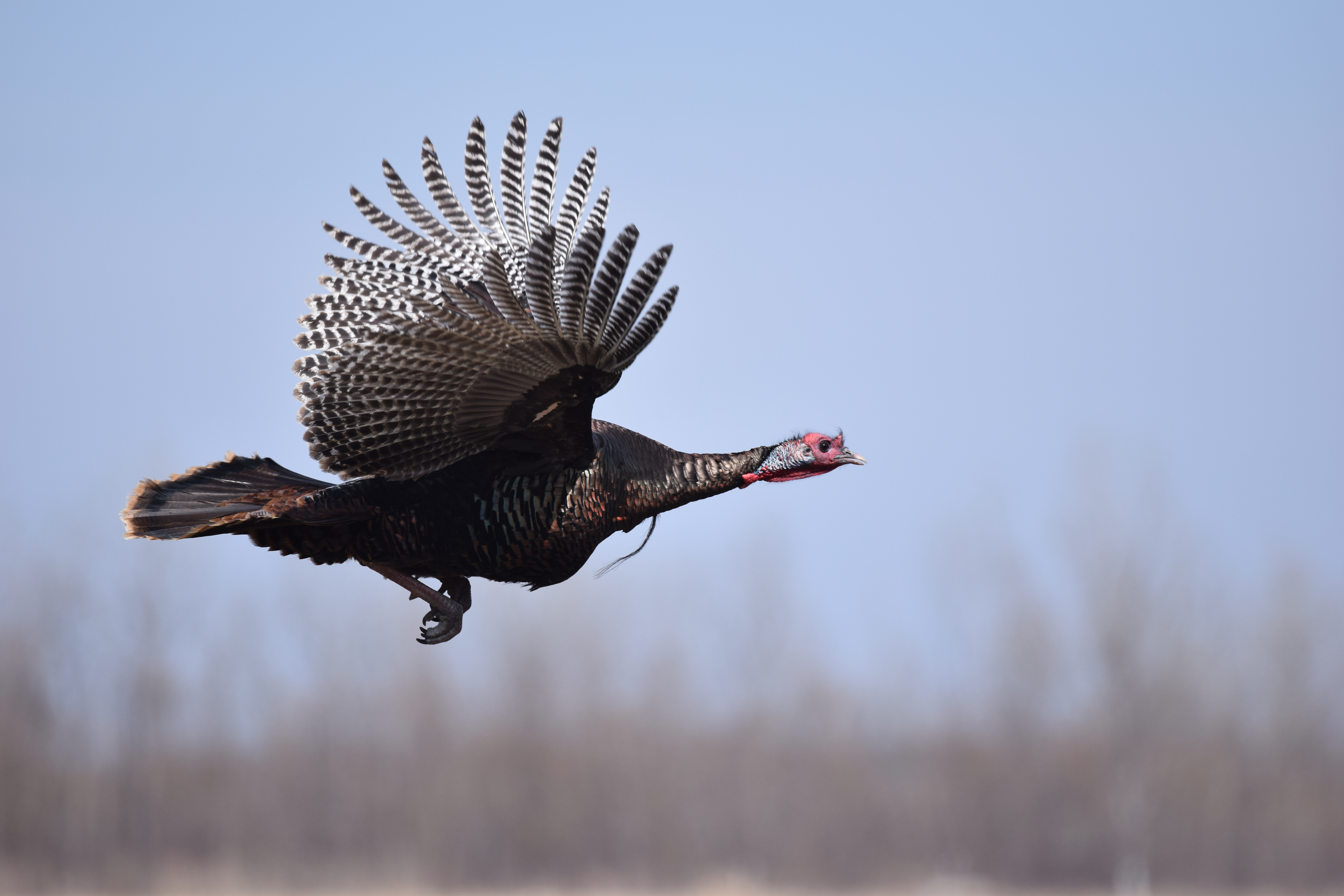One day while we were driving along a county road, a wild turkey shot out of the ditch just in time to collide with the mirror on the car. Needless to say, that was the turkey’s last flight. Instantly, it seemed, a buzzard dropped out of the sky to claim his thanksgiving dinner. Nature’s efficiency is amazing!
Wild turkeys (Meleagris gallopavo) are native to North and Central America. For centuries, they were domesticated by the Aztecs, and their meat and eggs provided an important food source. They were unknown to Europeans until, in the 1500s, Spanish explorers brought some back to Europe. There they were prized for their meat, and the domestication process was undertaken in earnest to make them even bigger and meatier. Today, our domestic turkeys are the descendants of those birds but trace their ancestry back to the original American turkey. The name “turkey” comes from this context as well. It is supposed at least, that they were called “turkeys” by the Europeans because they were shipped to Europe via trade routes through Turkey.
The saga of the wild turkey doesn’t end there, though. The wild birds were hunted in Iowa during the 19th century to the point that there were none left by 1910. In fact, although they were not technically extinct like the passenger pigeon, their population across the North American continent was in steep and dangerous decline. Over the next fifty years, several attempts were made to reintroduce the wild turkey to the Iowa landscape. These efforts all failed until, in 1966, some wild turkeys from Missouri were introduced in southern Iowa. This time it worked, and the Missouri turkeys began repopulating the species in the state. Today, some 120,000 wild turkeys, including those that live around Owl Acres, support a hunting season. In 2020, hunters bagged 14,671 wild turkeys or about 12 percent of the estimated population.
We all know what a turkey looks like with its dark brown feathers shining bronze-green iridescent in the sun and its nearly featherless head and neck. We like to show them with their tails fanned out like a peacock for our Thanksgiving emblems. But what’s that fleshy thing hanging down under the tom’s chin? And what good does it do the bird? It’s a wattle, and actually, it serves two purposes that Mr. Tom Turkey thinks are very important. The first is to help him keep cool in the summer. With that dense coat of 5,000 to 6,000 feathers covering his 20-pound body, he needs to cool off sometimes. His wattle helps him radiate heat. The other purpose is to attract the ladies and intimidate his rivals. During his mating dance, he knows that The bigger and redder the wattle, the more attractive he is to a potential mate. That goes for his snood, too-that peculiar bit that hangs down from his forehead and covers his beak. It can be five inches long or more in a mature male. When he’s excited, his snood turns bright red, too. The skin around his eyes turns blue at the same time. Around his neck and over his head he wears more red in the form of leathery red bumps called caruncles. The bigger and redder they are, the healthier and more attractive he is to the ladies. He also wears a beard which hangs down his chest. It’s made of specialized feathers that resemble plastic broom bristles and can grow to ten inches or longer. The females have smaller and less conspicuous forms of these accessories but don’t need to strut them to get the male’s attention. Handsome is as handsome does as they say. There is no universal standard for beauty.
Unlike domestic turkeys, wild turkeys can fly. They have a wingspan of over four feet, but their wings are relatively short and rounded. They are ideally suited to brief, powerful flight that they use to go from the ground into the branches of trees to escape predators or to find roosting sites. They can reach 55 miles per hour, but they are not suited for long or graceful flight. They have four toes on each foot and can run and swim, however, reaching running speeds of up to 25 miles per hour.
Wild turkeys don’t migrate. They stay home year-round building up fat reserves during the warm months which they can draw on in winter. They travel in groups which are variously called a flock, a rafter or a gaggle. “Rafter” seems odd, but one source suggested it referred to the fact that the turkeys needed big solid branches to roost on. “Gaggle” probably refers to the “gobble gobble gobble” sounds they make.
A turkey will spend most of its time on the ground, foraging for nuts, snails, insects and berries. The female also nests on the ground. She lays ten to twelve eggs over a period of 12 or so days, and then incubates them for another month. The poults as the nestlings are called, start flying short distances within two weeks of hatching, but take several months to mature. The eggs and young are vulnerable to a host of predators, including raccoons, opossums, snakes, rodents, birds, foxes, and skunks, so laying a dozen eggs is not an extravagance if some are to survive.
It is said that Benjamin Franklin once suggested that the turkey would make a better symbol as a more respectable bird than the bald eagle. Although its not flying with the eagles, the wild turkey would have pride of place on any Thanksgiving table. And how about complementing it with a dram of bourbon of the same name?
Photo by: Andy Reago & Chrissy McClarren

1 comment
The Turkey!!!! I do love that we see them all the time now. Not so when we were growing up!